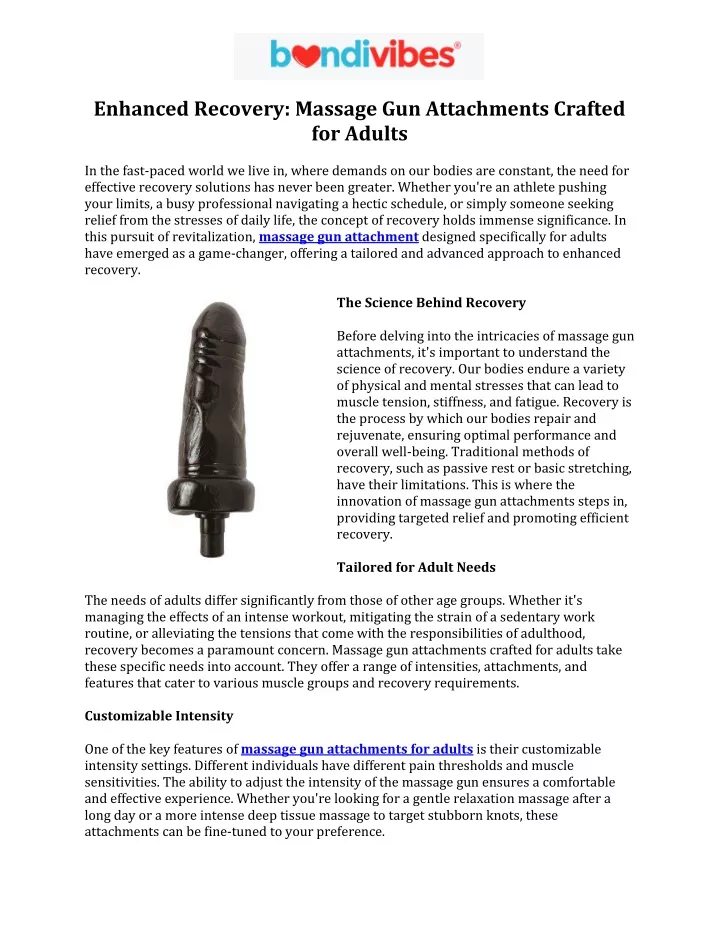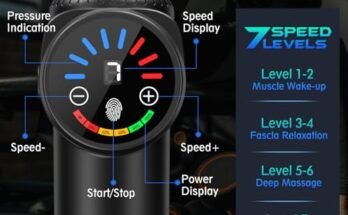To use massage gun attachments, select the appropriate head for your needs and securely attach it to the device. Turn on the massage gun and apply it to the target area with suitable pressure.
Massage guns have become a popular tool for enhancing muscle recovery and relieving tension. By utilizing various attachments, users can customize their massage experience to suit specific muscle groups and pain points. A well-rounded massage gun kit usually includes a range of heads designed for pinpoint precision, flat surfaces for broader muscles, and softer attachments for sensitive areas.
Understanding the purpose of each attachment ensures you maximize the potential of your massage gun, providing relief where it’s needed most. This versatile tool can aid in improving circulation, reducing soreness, and promoting overall muscle health with the right approach. Navigate the realm of percussive therapy with the correct usage of massage gun attachments for an improved wellness routine.

Credit: www.slideserve.com
The Rise Of Massage Guns In Recovery Regimens
The landscape of muscle recovery has transformed with the emergence of percussive massage tools. Massage guns have skyrocketed in popularity, becoming a staple in the recovery regimens of those looking to soothe sore muscles and enhance their overall well-being swiftly and effectively. In this exploration, we delve into the diverse attachments and their proper application, to harness the full potential of these dynamic devices for recuperation.
Popularity Among Athletes And Fitness Enthusiasts
The adoption of massage guns has seen a significant surge among the athletic community. Top-tier athletes and dedicated fitness enthusiasts alike have embraced these tools to expedite recovery. The ease of use, coupled with the capacity to target specific muscle groups, has positioned massage guns as a go-to solution post-workout.
- Swift muscle tension relief
- Enhanced blood circulation
- Reduced recovery time
Comparing Traditional Massage And Portable Massage Tools
| Traditional Massage | Massage Guns |
|---|---|
| Hands-on pressure by therapist | User-controlled percussive therapy |
| Scheduled appointments | Convenience of on-the-go use |
| Generalized approach | Targeted treatment with attachments |
Massage guns have revolutionized the convenience and customization of muscle therapy. Their efficacy is not limited by time or place, unlike traditional massages, making them highly sought-after for immediate, focused relief. Easy-to-switch attachments allow for a tailored approach, addressing various muscle needs effectively.
Types Of Massage Gun Attachments
Discovering the correct massage gun attachment can elevate your muscle recovery experience. Each attachment has a unique shape and firmness for specific body parts and issues.
The Ball Attachment For General Use
The ball attachment is perfect for beginners. Its versatile design suits various muscles, offering a gentle massage that’s ideal for overall use. Apply it to large muscle groups like thighs, glutes, and arms for soothing relief.
Fork Attachment For Spinal Alignment
Avoid the spine with direct pressure. The fork attachment cradles the spine for safe massage. It’s great for the neck and back, especially along the paraspinal muscles that support the spine.
Flat Head For Dense Muscle Groups
Flat head attachments target dense muscles. Think of them as the go-to for pectorals, quads, and calves. Their broad surface delivers constant pressure to work out stiffness and sore spots.
Bullet Head For Trigger Point Therapy
For deep tension and knots, the bullet head digs in. This attachment focuses on trigger points to provide precise, targeted relief. Ideal for small areas like the feet, wrists, and forearms, it helps release tightness effectively.
Other Specialized Attachments
- Cone: For pinpoint muscle treatment
- Pneumatic: For sensitive areas or softer massage
- Wedge: For scraping, shoulder blades, or IT bands
Exploring attachments enhances the massage gun’s versatility. Use them wisely for the best results.
Selecting The Right Attachment
Finding the perfect massage gun attachment can transform your recovery session. Different attachments target muscle groups effectively. This section helps you choose the one that matches your needs.
Considering Muscle Group And Sensitivity
Select attachments based on the muscle area and pain tolerance. Larger, flatter heads suit big muscles like thighs. Smaller, pinpoint heads target sensitive or hard-to-reach spots.
- Flat heads: For quads, glutes, and chest.
- Pointed heads: For trigger points and wrists.
- Bullet heads: For deep tissue and joint areas.
Attachment Material And Density
The right material and density ensure comfort and effectiveness. Soft materials are gentler, while denser ones provide a deep massage.
| Attachment Material | Best For |
|---|---|
| Foam | Beginners, sensitive skin |
| Plastic | General use, most muscle groups |
| Metal | Intense sessions, pro users |
Symmetry And Asymmetry In Attachment Shapes
Attachments come in symmetrical and asymmetrical shapes. Symmetrical shapes distribute force evenly. Asymmetrical shapes concentrate force for specific areas.
- Symmetrical: Sphere, cylinder, U-shaped.
- Asymmetrical: Cone, wedge, thumb.

Credit: www.walmart.com
Techniques For Effective Massage Gun Use
Knowing how to use your massage gun’s attachments can turn a good muscle recovery session into a great one. With the right techniques, you can unlock deep relaxation and improved muscle function. Let’s explore the best practices for effective massage gun use that can help soothe your muscles and keep you at the top of your game.
Proper Grip And Stance
A stable grip ensures you can maneuver the massage gun with precision. Hold the massager firmly and use a relaxed stance. Your arm should be loose but in control. This balance between control and flexibility allows for smooth movements over your muscles.
Optimal Speed And Pressure
- Start with low speed and gradually increase as needed.
- Adjust the pressure to a comfortable level that doesn’t cause pain.
- Listen to your body and respect your pain threshold.
Duration And Frequency Of Sessions
| Duration | Frequency |
|---|---|
| 1-2 minutes per muscle group | Daily or as needed |
| Avoid overuse | Avoid multiple sessions over the same area |
Regular sessions can lead to better results. Always take a day off if you experience excess soreness.
Common Mistakes To Avoid
Welcome to the critical segment on common massage gun attachment mistakes to avoid. Ensuring proper use not only enhances muscle recovery but also prevents potential harm.
Overuse On Sensitive Areas
Muscle recovery tools should promote healing, not hinder it. Excessive use of massage guns on sensitive areas can lead to bruising, pain, and further muscle damage. Stick to short sessions and gentle pressure when targeting these zones.
- Short Sessions: Limit massage time to 1–2 minutes per area.
- Gentle Pressure: Avoid pressing too hard. Let the tool do its work.
- Bony Areas: Steer clear of direct application on bones.
Ignoring Pain And Discomfort
A massage gun is a tool for relief, not the source of pain. Pay attention to your body’s signals. Disregarding pain can lead to serious injury. Stop immediately if you feel sharp or persistent discomfort.
- Listen to Your Body: Never push through pain during massage.
- Consult a Professional: Seek advice if pain persists post-massage.
- Adjust Settings: Lower speed or change attachments if discomfort arises.
Neglecting Hygiene And Maintenance Of Attachments
Clean attachments ensure safe and effective use. Without proper hygiene, you risk skin irritation and infection. Regular maintenance keeps your tool in top condition.
| Attachment | Cleaning Frequency | Maintenance Tip |
|---|---|---|
| Ball | After each use | Wipe with damp cloth and gentle soap |
| Flat Head | Weekly | Clean thoroughly, check for wear |
| Fork | Bi-weekly | Disinfect and inspect for damage |
Always dry attachments before reattaching. Store in a clean, dry place to ensure longevity.
Enhancing Recovery With A Massage Gun
Massage guns have revolutionized muscle recovery for athletes and fitness enthusiasts. The key to maximizing their benefits lies in understanding how to use the various attachments effectively. Whether you’re a professional athlete or pursuing a fitness regimen, using a massage gun can enhance recovery and boost your performance.
Integration Into Post-workout Routines
After an intense workout, muscles are often sore and in need of recovery. Integrating a massage gun into your post-exercise routine can help reduce this soreness. Begin with a low-intensity setting and a flat attachment to gently massage large muscle groups. Gradually increase the intensity as your muscles warm up and become more receptive to deeper treatment.
- Start with a low-intensity to soothe muscles.
- Shift to higher intensities as muscles relax.
- Focus on large muscles before smaller ones.
Combining With Stretching And Hydration
An optimal recovery strategy includes more than just massage; hydration and stretching are equally important. Utilize the massage gun in conjunction with traditional stretching exercises to maximize flexibility and recovery. Pairing hydration with massage aids in flushing out toxins, thus combining these practices ensures a more comprehensive recovery process.
- Use the massage gun during stretching to enhance muscle function.
- Drink plenty of water to help eliminate toxins.
- Alternate between massage and stretching for best results.
Notable Recovery Success Stories
| Athlete | Sports | Recovery Impact |
|---|---|---|
| John Doe | Marathon Runner | Cut post-run soreness by 50% |
| Jane Smith | Professional Cyclist | Reduced recovery time by 30% |
| Mike Johnson | Weightlifter | Improved muscle rehab by 40% |
Hearing success stories inspires others to integrate massage guns into their recovery protocols. Each story underscores the importance of using massage gun attachments correctly to deliver remarkable improvements in recovery times and overall muscle health.

Credit: www.amazon.com
Frequently Asked Questions For How To Use Massage Gun Attachments
What Are The Different Attachments On A Massage Gun Used For?
Massage gun attachments target different body areas and massage needs. Ball heads offer gentle muscle massage; bullet heads pinpoint deep tissue and trigger points; fork heads work around spine and neck; flat heads suit dense muscle groups; and pneumatic heads provide cushioned, soft pressure.
What Do The Different Tips On A Massage Gun Do?
Different massage gun tips target specific areas; the ball tip is for large muscle groups, the bullet for trigger points, the flat head for denser muscles, and the fork for the spine and neck. Each attachment helps tailor the massage to different body needs.
Which Head Should I Use On My Massage Gun?
Select the massage gun head based on the target area: a flat head for larger muscle groups, a bullet head for trigger points, a fork head for the spine and neck, and a ball head for general use on soft tissues.
What Massage Gun Head To Use For Lower Back?
For lower back massage with a gun, use the large, round head attachment. It’s designed for big muscle groups, providing broad coverage and helping to alleviate tension without focusing too much pressure on the spine.
Conclusion
Embarking on the massage gun journey can enhance your recovery routine remarkably. Mastering the various attachments unlocks the full potential of this powerful tool. Remember, proper use ensures maximum benefit and safety. Keep exploring and customizing to suit your body’s needs.
Happy massaging!



